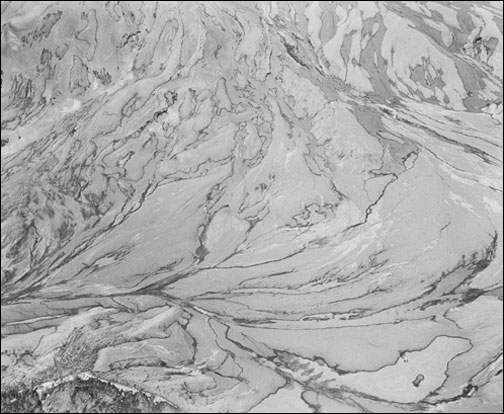Nature’s Dark Side
On May 18, 1980, Mt. Saint Helens erupted with the power of a nuclear explosion, expelling volcanic ash fourteen miles into the sky. Images of ghost forests, fuming plains and blackened ash-choked skies dominated headlines and news broadcasts. Ash, in the form of a fine gray dust, later rained down on the Pacific Northwest from Seattle, Washington to my hometown of Eugene, Oregon.

Fifty-seven people who were near the eruption lost their lives, some of them campers, lost in the woods, who couldn’t escape the lethal cascade of ash. But for me, at the time, Mt. Saint Helens seemed very far away. I was focused on my work as a ceramist and like other area potters, I used Mt. Saint Helens ash to glaze ceramic vessels. In the fires of a kiln this ash turned a deep, rich brown, like the essence of old-growth timbers that were felled in its conflagration.
Frank Gohlke at the Modern
Frank Gohlke visited the volcano five times between 1981 and 1990, selectively photographing the 250 square-mile swath of land that had been claimed by the eruption. His work documents both the immense destructive forces of nature and her uncanny ability to adapt and renew in the face of seemingly total devastation. The photographs are currently on view at the Museum of Modern Art in an exhibition curated by John Szarkowski and Peter Galassi that will run through September 29. The exhibition consists of 44 black-and-white photographs that span his near decade-long dialogue with the mountain.

One striking image depicts a downed forest near Elk Rock, some ten miles from Mt. Saint Helens, which was photographed from the air shortly after the eruption. It calls to mind images of the bombed out and fire-scorched forests of Europe during World War I, but here the destruction is more complete and as if by design. During the eruption, trees fell against the wall of heat in a single direction, and here lie parallel as far as the eye can see. Stripped of their foliage, these massive trunks resonate in some deep primal way with our innate fear of and respect for nature.
Another photograph captures the intermingling of ash and snow on the east flank of Mt. Saint Helens some two years after the eruption. The day after the 9.11 tragedy, I walked to Battery Park City and remember the eerie effect of the ash which seemed to have fallen like a blanket of snow on the trees and buildings. In Gohlke’s photographs these two kindred elements create an effect like marbled 19th century endpapers. On closer examination, the viewer comes to appreciate the bizarre landscape they define, punctuated with lava flows and Lilliputian tree trunks which lie lifeless at their feet.
Somehow Gohlke also photographed Mt. Saint Helens’ crater and lava dome from the air, capturing its most minute details. A plume of ash and vapor wisps into the sky from the mysterious vent in the center of the dome, belying latent pressure that is still beneath the earth and which can surface unexpectedly. Lava, ash, hot vapor and snow populate this netherworld at the summit of the volcano.

In antiquity, Pliny the Younger witnessed the eruption of Mount Vesuvius from a ship in the Bay of Naples and for centuries, Pliny’s rather dry descriptions from letters were the only testimony by which others could understand this momentous event. Through Gohlke’s lens, we all bear witness to the eruption of Mt. Saint Helens and the cycle of destruction by which natures transforms itself. The artist’s sensitivity in framing both grand vistas and intimate environments convey a sense of nature’s infinite complexity and paradoxical order in chaos.
Nature Reexamined
Nature’s dark side has been explored in recent years by numerous artists, including Alexis Rockman and Walton Ford. Both employ humor to make a point about the brutality and adaptability of nature and the environment.
Alexis Rockman’s Manifest Destiny is a large-scale mural which depicts a sunrise over Brooklyn sometime in the distant or not-so-distant future. The once populous borough is now underwater with only an occasional high building or triumphal arch that breaches the surf. Man-o-war jellyfish glide through the now semi-tropical waters of Gotham. A fearsome sea snake gives chase to a swimming rat, which, having survived this cataclysmic flood, paddles once again for its life. Seabirds pick at urban flotsam while that indomitable survivor the cockroach rides atop an oil drum which buoys in the surf. The unnatural colors and polluted nature of the landscape suggest a legacy of neglect and global warming may have invited this frightful transformation. Rockman’s humorous yet disturbing seascape suggests the devastation invited upon ourselves by abuse of the environment, to which tsunamis, eruptions, and earthquakes are decidedly insignificant.

Painting in the style of John James Audubon, Ford depicts animals in a sometimes-debased state of nature. Nila (Swadeshi-phobia) is a characteristic painting of 2000 which depicts and Indian elephant walking along, her body hosting a plethora of flying parasites from roosters to barn swallows. Nila unwittingly crushes one of the birds underfoot as she ambles forward. Falling Bough, a painting of 2002, captures the downward flight of a dead log, surrounded by a swarm of birds. Flocks of avian predators populate the skies far into the distance.

Destruction and regeneration are essential themes in nature that can be witnessed from her grandest to most minute gestures. Lately her destructive force has prompted a different renewal in the form of art. This is most intriguing because, in the end, we as human beings are very much part of the natural world and contribute to her balance for both good and ill.
© 2005 Daniel Rothbart. All rights reserved.